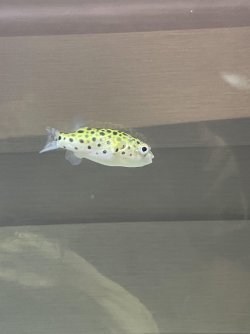taryn0214_
New Member
Hi,
I have a green spotted puffer for almost a week now. I think his health condition is not so stable as he sometimes very active, sometimes won't be greeting us but hiding and resting on the gravel.
Last night, I realized that he's flashing, he's scratching his body against the plants a few times. I thought he was just having fun at first but later I googled the behavior, it might indicate the parasite.
He will sometimes happily swim to us when we approach but sometimes he'll just turn away and looked ill (or I am just overthinking). He wasn't in a good appetite until these two days he started to eat quite a lot after I switch frozen krills to bloodworm. Not sure if he just doesn't like krill.
I am very worried and this is the first puffer I ever have. I know that brackish puffer is not easy to start with as I am a newbie therefore I did a lot of research before I got the fish.
Now he keeps having issues and I am just freaking out...
I did a water test every two days and here's some info for my water parameters:
37 gallon
ph 8.0-8.2
Temperature 80F
Ammonia below 0.2ppm (I have used the API AmmoLock treatment every two days with only 5ml dose, and I know puffers are sensitives)
Nitrite 0
Nitrate 5.0ppm
SG 1.004
I need some puffer pro to help me out with the flashing behavior, I have attached some photos of his skin. There are some little bulge dots or his spine? but it feels like when aftershave beard...
Please and I appreciate your help!!
I have a green spotted puffer for almost a week now. I think his health condition is not so stable as he sometimes very active, sometimes won't be greeting us but hiding and resting on the gravel.
Last night, I realized that he's flashing, he's scratching his body against the plants a few times. I thought he was just having fun at first but later I googled the behavior, it might indicate the parasite.
He will sometimes happily swim to us when we approach but sometimes he'll just turn away and looked ill (or I am just overthinking). He wasn't in a good appetite until these two days he started to eat quite a lot after I switch frozen krills to bloodworm. Not sure if he just doesn't like krill.
I am very worried and this is the first puffer I ever have. I know that brackish puffer is not easy to start with as I am a newbie therefore I did a lot of research before I got the fish.
Now he keeps having issues and I am just freaking out...
I did a water test every two days and here's some info for my water parameters:
37 gallon
ph 8.0-8.2
Temperature 80F
Ammonia below 0.2ppm (I have used the API AmmoLock treatment every two days with only 5ml dose, and I know puffers are sensitives)
Nitrite 0
Nitrate 5.0ppm
SG 1.004
I need some puffer pro to help me out with the flashing behavior, I have attached some photos of his skin. There are some little bulge dots or his spine? but it feels like when aftershave beard...
Please and I appreciate your help!!



